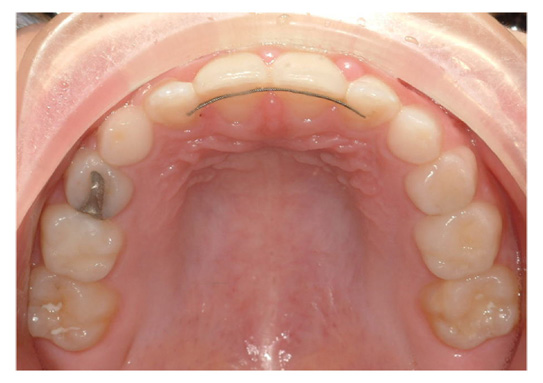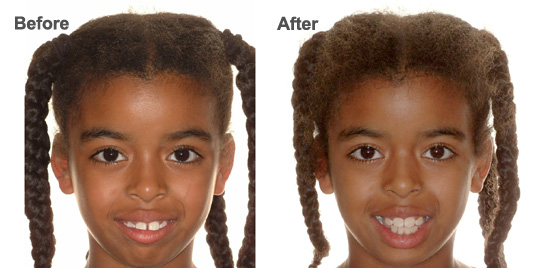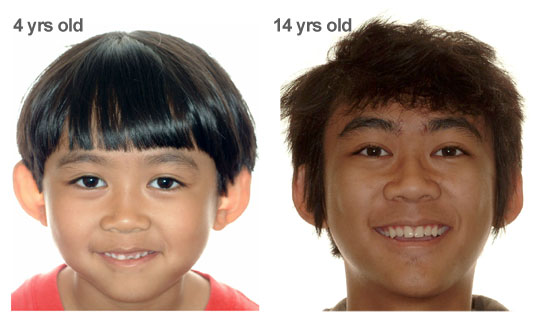January 19th, 2016

A GAP BETWEEN YOUR seven year old's front teeth may look cute at 7, but unless you're Madonna, it may not be wanted in adolescence or adulthood. To prepare for your child's future, many 7 year olds have their gap closed by orthodontic treatment.

A gap, or diastema, is common at age 7 when half baby teeth and half permanent teeth are present. Orthodontic treatment at age 7 is called Phase 1 Orthodontic Treatment. It is treatment of half permanent teeth. Additional Phase 2 treatment of all permanent teeth may be needed at age 12.
If a diastema is larger than 2mm, it will not close on it's own. Your orthodontist can help to close this space and get your 7 year old's teeth looking beautiful.

A diastema is often caused by a thick frenum, a piece of skin between the front teeth. Frenums are often hereditary in families. The frenum is best removed once the diastema is closed. The space will be held closed by a wire on the back side of the front teeth.

A periodontist, or gum specialist, will remove your child's frenum to make space closure permanent. Frenum removal is done AFTER the space is closed by your orthodontist.

If you have questions about your child's diastema or frenum, Orthodontist Dr. Ann Marie Gorczyca and Gorczyca Orthodontics can help. Call us at (925) 757-9000 or visit us at www.clubbraces.com.
Goodbaye Gap! Hello happiness! Here's to looking at your 7 year old's beautiful face, teeth, and smile!
Tags: Antioch, orthodontist, dentistry, orthodontics, braces, dental, Moms, seven year olds, Phase 1 braces, fixed retainer, children, kids, parents, parenting, mums, diastema, gap, lingual retainer, pediatric dentistry, pediatrics, Phase 2 braces
Posted in Blog | No Comments
January 14th, 2016

WHEN YOUR FOUR-YEAR-OLD says “Cheese!” at her birthday party, take time to notice if her bite is right.
Most children see a pediatric dentist by age two. By age four, your child may be referred to an orthodontist for severe tooth and bite problems.

There are four childhood conditions treated by an orthodontist as early as age four.
1. Crowded Baby Teeth
Baby teeth should have spacing between them. Overlapped baby teeth are a sign of severe crowding. The permanent front teeth are larger than the baby teeth they replace and need adequate space.
2. Crossbite of Baby Teeth
Crossbite occurs when upper teeth fit inside the lower teeth. If your four year old is experiencing difficulty chewing or bites her cheeks, she may have a crossbite. A crossbite can cause grinding and wearing down of baby teeth. Long term, a crossbite will create an abnormal growth pattern.
3. Lower Jaw Shift with Baby Teeth
Baby teeth out of position can create interference tooth hitting and produce a lower jaw shift. Tooth interference with jaw shifting will wear down teeth and create an abnormal growth pattern.
4. Narrow Upper Jaw with Baby Teeth
A narrow upper jaw indicates narrow nasal passages. This can create open-mouth breathing and sleep problems. Lack of sleep can significantly contribute to difficulty learning at school.

Correction of these early bite problems is of great health benefit to your four year old child. Early treatment by an orthodontist will minimize the need for more extensive orthodontic treatment at a later age.

To Find An Orthodontist Near You...
To find an orthodontist near you, visit the American Association of Orthodontists at mylifemysmile.org. To find a pediatric dentist nearby, you can visit the American Academy of Pediatric Dentistry (AAPD) at mychildrensteeth.org.
This patient was treated by Orthodontist Dr. Ann Marie Gorczyca of Gorczyca Orthodontics, in Antioch, California. For a free consultation call (925) 757-9000.
Make sure your child’s bite is healthy when saying “Cheese!” and that she enjoys eating her birthday cake at age four, or any age.
Tags: dentistry, orthodontics, braces, Antioch braces, Antioch orthodontist, Dr. Ann Marie Gorczyca, bite, crossbite, expansion, Moms, Primary Teeth, Baby teeth, functional shift, parents, sleep apnea, babyteeth, Four-year-olds, parenting, Pediatric, mums
Posted in Blog | No Comments
















